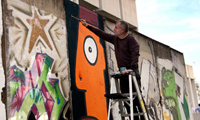 It was a stunning work of art – so why is the Wall hanging in a Las Vegas loo?
It was a stunning work of art – so why is the Wall hanging in a Las Vegas loo?A stupendous human artefact ... Thierry Noir paints a relocated section of the Berlin Wall in Los Angeles last year. Photograph: Nick Ut/AP
The greatest artwork of the 20th century was 100 miles long and nearly 12ft high. A multitude of hands took 13 years to make it, out of house paint, vehicle paint, spray paint, any paint they could find. They had to work fast to evade the border police, for they were working three metres inside the perimeter of East Berlin. Defacing any part of the border installation was streng verboten.
The rough stone and cement blocks of earlier Berlin walls had offered little opportunity for anything but slogans, awkwardly lettered with a broad brush, and the odd wobbly sight joke. Border Wall 75, which began to replace them in 1976, was made of smoother cement panels that were, unwisely, painted white. Gradually, artists began to cover the western face with words and images, some vivid, some feeble, some accomplished. There were no rules, beyond the subtle discipline of graffiti everywhere. Good stuff would be respected, but weak stuff would be drawn and painted over, making a palimpsest of protest old and new.
In April 1984, two Frenchmen living in a squat not far from the wall began to paint on it on a larger scale. Thierry Noir painted over the existing graffiti, rapidly covering whole panels. When passers-by objected, he pretended not to understand. Christophe Bouchet preferred to use the earlier graffiti as bases for his own designs. The eventual aim was to produce a painting five kilometres long.
In 1989, the wall began to come down. At first, the mauerspechte (wall-peckers) chipped off small pieces, eventually making holes big enough to walk through. The East German government then took the wall down. There was no outcry. Berliners were only too glad to see the wall go. Most of it was smashed up to make road base, but the more striking panels were placed in storage. Small sections were deliberately left, at Potsdamer Platz, on Bernauer Strasse and on Mühlenstrasse. Artists from all over the world were invited to paint the eastern face of the fragments left standing, in a visual enactment of reunification, and so posterity was granted to the Wall Park and the East Side Gallery, a 1.3km section of wall.
Celebration does not fire the imagination or drive the arm the way protest does. In 1990, even Noir and Bouchet could only manage to parody their earlier work. Other artists used the opportunity to promote themselves, in profound contradiction to the spirit of the wall. The cement panels are now sagging and crumbling, and the paint is flaking off. The East Side Gallery has been restored, for the second time, at a cost of €2m – money well spent as it is now Berlin's leading visitor attraction. Many of the tourists are unaware that the slick images they have come to see were no part of the historic wall.
When artist Edwina Sandys arrived in Berlin in February 1990, she was told by the East German minister of culture that, if only she had come a few weeks earlier, she could have taken whatever she wanted and no questions would have been asked. As it was, government agents were preparing to sell panels off at $60,000 each (10 times what the last authenticated panel actually fetched when it was auctioned in 2008). Sandys, who is a granddaughter of Winston Churchill, was hoping to use sections of the wall as the basis of her own sculpture for the Churchill Memorial and Library at Westminster College Fulton, Missouri (where Churchill made his famous "iron curtain" speech). She was eventually allowed to choose eight from 400 "better pieces" of the wall for shipping to New York, where she had male and female silhouettes cut out of them by high-pressure water jets to make her own sculpture, Breakthrough, unveiled by Ronald Reagan in November 1990. The pieces also became part of a second sculpture called Breakfree, now at the Roosevelt Library in New York.
Sandys was probably the last or even the only person to persuade the East Germans to let her have bits of the wall for free. In June 1990, 81 segments from the Waldemarstrasse, including 33 painted by Thierry Noir and 12 by Kiddy Citny were put up for auction in Monaco, where they fetched €1.5m. Noir immediately sued for a share of the proceeds. Litigation dragged on until February 1995, when his claim was upheld.
Until recently, no concerted attempt was made to document the wall. There are few colour photographs beyond those taken by Noir to record his and Bouchet's activities. Now, German documentary film-maker Hartmut Jahn has traced fragments of the wall as far as the US, where they can be seen in a men's room in a Las Vegas casino, in a floating restaurant in Maine, in the Microsoft cafeteria in Redmond, Washington, at Fort Knox, at the Hard Rock Cafe in Orlando, in the headquarters of the CIA in Virginia, on Ronald Reagan's ranch – and to Poland, Italy, Spain, and Japan. Since mid-2009, Jahn has been mounting exhibitions of panoramic photographs called variously The New Owners of the Wall and The Berlin Wall – Sold Out. His photographs are the final proof that a stupendous human artefact has been lost forever.
 It was a stunning work of art – so why is the Wall hanging in a Las Vegas loo?
It was a stunning work of art – so why is the Wall hanging in a Las Vegas loo?